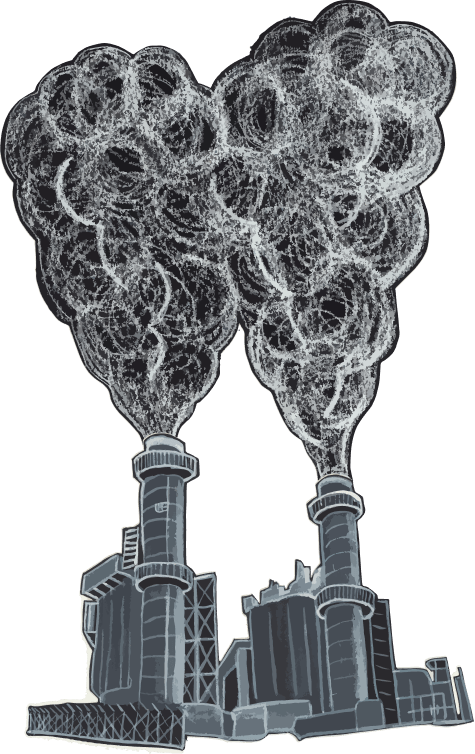Pennsylvania
Back to mapTo get to zero by 2050, Pennsylvania must cut emissions by 3.8% a year
Emissions in Pennsylvania
Million metric tons of carbon dioxide (CO2) equivalent (MTCO2e
) emissions
Note: Grey area indicates missing data due to processing delays.
Source: WRI, Mar 2021
This is how we're going to do it
- Boilers and furnaces with heat pumps
- Gas stoves with electric induction stoves
- No-till farming to keep CO2 in the soil
- Capturing methane leaks from landfills
- Capturing CO2 to make emissions-free concrete
- Burning green hydrogen to make emissions-free steel
- Plugging methane leaks from gas pipelines
Decarbonize Our Buildings
13% of Pennsylvania's climate pollution comes from buildings.
We burn fossil fuels to heat our air, water, and food.
To cut this pollution...
Let's electrify our heat!
We'll replace...
...in all of Pennsylvania's 5.0 million buildings.
In fact, 30.9% of appliances in buildings in Pennsylvania are already fossil fuel free!
That means we only need to electrify the remaining 3.4 million dirty buildings in Pennsylvania. That's around 130,000 per year.
Source: Microsoft, Mar 2021; NREL, Dec 2021Electrifying all buildings cuts 13% of the pollution.
Decarbonize Our Transport
24% of Pennsylvania's pollution comes from cars, trucks, trains, and planes.
But mostly from cars.
To cut this pollution,
your next car must be electric.
Or consider going car-free with public transit, bikes/e-bikes, car share, or other alternatives!
There are 4.0 million vehicles in Pennsylvania and 18,000 are already electric (0.4% of the total).
We need to electrify (or replace) the remaining 4.0 million gas-powered vehicles. That's around 153,000 a year.
Source: DOT, Feb 2021Electrifying all transportation cuts 24% of the pollution.
Decarbonize Our Power
27% of Pennsylvania's pollution comes from burning coal, gas, and oil to make power.

That's because of how power is generated in Pennsylvania today.
Power Generation in the State of Pennsylvania (2020)
But there's already 37% carbon-free electricity generation in Pennsylvania!
To clean up the emissions from the polluting power plants we need to replace all fossil fuel power plants with solar and wind farms.

...and find good jobs for those workers.
Current Fossil Fuel Power Plants in Pennsylvania
21 coal plants
2,741 MW
2,012 MW
1,963 MW
1,883 MW
1,775 MW
1,624 MW
803 MW
637 MW
134 MW
118 MW
99 MW
98 MW
95 MW
94 MW
88 MW
84 MW
58 MW
48 MW
47 MW
36 MW
31 MW
63 gas plants
1,665 MW
1,569 MW
1,569 MW
1,338 MW
1,197 MW
1,194 MW
1,153 MW
1,134 MW
1,058 MW
898 MW
870 MW
870 MW
836 MW
778 MW
728 MW
688 MW
652 MW
644 MW
632 MW
621 MW
614 MW
556 MW
525 MW
424 MW
416 MW
295 MW
193 MW
172 MW
146 MW
137 MW
120 MW
94 MW
93 MW
88 MW
88 MW
88 MW
69 MW
51 MW
44 MW
43 MW
43 MW
43 MW
24 MW
24 MW
24 MW
22 MW
22 MW
22 MW
17 MW
16 MW
13 MW
8 MW
7 MW
7 MW
6 MW
6 MW
6 MW
4 MW
2 MW
2 MW
1 MW
1 MW
1 MW
26 oil plants
2,112 MW
546 MW
491 MW
392 MW
261 MW
233 MW
132 MW
74 MW
64 MW
64 MW
64 MW
64 MW
60 MW
56 MW
54 MW
54 MW
37 MW
37 MW
32 MW
32 MW
32 MW
27 MW
20 MW
20 MW
5 MW
4 MW
But wait!
It's not enough to replace our power plants with wind and solar farms.
To power our electric cars and buildings, we need two times the electricity we have today.
In all, we'll need to build 16,000 megawatt (MW) of wind power and 17,000 MW of solar power.
Since the average wind turbine provides 2.75 MW of peak capacity, Pennsylvania would need to install about 6,000 turbines.
Since Pennsylvania already has 404 MW of wind and 110 MW of solar, that's 16,000 MW of wind power we need to build and 17,000 MW of solar power. That's around 610 MW of wind power and 641 MW of solar power a year.
Source: EIA, Apr 2022Decarbonizing all dirty power cuts 27% of the pollution.
And gives us zero-emissions power we need to eliminate pollution from buildings and cars!
Other Emissions
The last 36% of Pennsylvania's climate pollution comes from other sources...
This includes farming, landfills, industry, and leaks from gas pipelines.
There's no one solution to solve these problems, but there are lots of great ideas:
That doesn't mean there's no solution, it just means that clean electrification doesn't help with these problems, and you could fill a whole book with covering all of them. We need to encourage our politicians to invest in researching new solutions and implementing existing solutions to these problems!
Ready to do your part?
Learn how to electrify your own machines and pass local policy to electrify the rest
Take Action